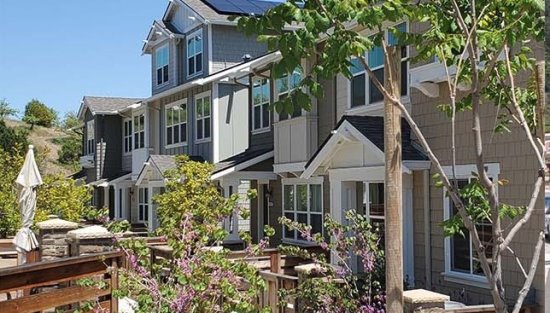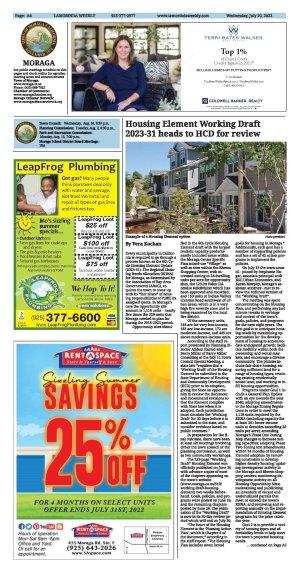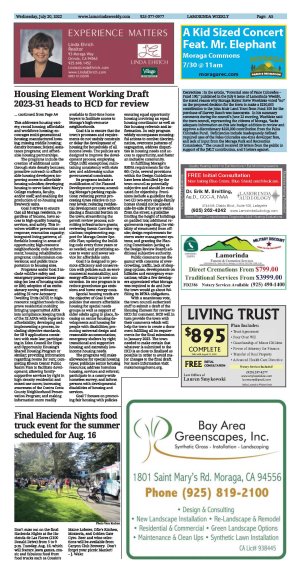| | Published July 20th, 2022
| Housing Element Working Draft 2023-31 heads to HCD for review
| | | By Vera Kochan |  | | Example of a Housing Element option Photo provided |
Every municipality in California is required to go through a process known as the 6th Cycle Housing Element Update (2023-31). The Regional Housing Needs Allocation (RHNA) for Moraga, as determined by the Association of Bay Area Governments (ABAG), requires the town to come up with its "fair share" of housing responsibilities to fulfill its assigned quota. In Moraga's case the opportunity site amount is 1,118 units - nearly five times the 229 units that Moraga needed to plan for during the 2015-2023 period.
 Opportunity sites identified in the 6th Cycle Housing Element draft with the largest realistic capacity predominantly included areas within the Moraga Center Specific Plan mixed-use "Village" as well as sites within the Rheem Shopping Center, with increased zoning to 24 dwelling units per acre for opportunity sites, the 123-lot Palos Colorados subdivision which has been approved and recorded, and 150 units at Indian Vallley (Canyon Road southwest of urban area), which is in a very high fire severity zone and is being examined by the local fire district.
Opportunity sites identified in the 6th Cycle Housing Element draft with the largest realistic capacity predominantly included areas within the Moraga Center Specific Plan mixed-use "Village" as well as sites within the Rheem Shopping Center, with increased zoning to 24 dwelling units per acre for opportunity sites, the 123-lot Palos Colorados subdivision which has been approved and recorded, and 150 units at Indian Vallley (Canyon Road southwest of urban area), which is in a very high fire severity zone and is being examined by the local fire district.
 Of the necessary units, 318 are for very low-income, 183 are low-income, 172 are moderate-income, and 445 are above moderate-income units.
Of the necessary units, 318 are for very low-income, 183 are low-income, 172 are moderate-income, and 445 are above moderate-income units.
 According to the staff report presented by Planning Director Afshan Hamid and Barry Miller of Barry Miller Consulting at the July 11 Town Council Special Meeting, a state law "requires that a `Working Draft' of the Housing Element be submitted to the State Department of Housing and Community Development (HCD) prior to its adoption, giving the State an opportunity to review the document and recommend revisions so that the Element complies with State law when it is adopted. Each jurisdiction must circulate the 'Working Draft' for 30 days before it is submitted to the state, and consider revisions based on public comment."
According to the staff report presented by Planning Director Afshan Hamid and Barry Miller of Barry Miller Consulting at the July 11 Town Council Special Meeting, a state law "requires that a `Working Draft' of the Housing Element be submitted to the State Department of Housing and Community Development (HCD) prior to its adoption, giving the State an opportunity to review the document and recommend revisions so that the Element complies with State law when it is adopted. Each jurisdiction must circulate the 'Working Draft' for 30 days before it is submitted to the state, and consider revisions based on public comment."
 In preparation for the final outcome, there have been at least six meetings involving either the town council or the planning commission, as well as two community workshops.
In preparation for the final outcome, there have been at least six meetings involving either the town council or the planning commission, as well as two community workshops.
 The 225-page "Working Draft" Housing Element was officially published on June 30 with advance copies of most of the chapters appearing on the town's website (www.moraga.ca.us/519/
The 225-page "Working Draft" Housing Element was officially published on June 30 with advance copies of most of the chapters appearing on the town's website (www.moraga.ca.us/519/
 working-draft-housing-element) two weeks beforehand. Goals, policies, and programs were posted on June 16, and the remaining chapters posted by June 28. The publication of the "Working Draft" is now in its 30-day review period which will end on July 30.
working-draft-housing-element) two weeks beforehand. Goals, policies, and programs were posted on June 16, and the remaining chapters posted by June 28. The publication of the "Working Draft" is now in its 30-day review period which will end on July 30.
 "The heart of the Housing Element is the `Housing Action Plan', which is Chapter 6 of the document," according to the staff report. "The Housing Plan includes seven broad goals for housing in Moraga." Additionally, each goal has a number of supporting policies and has a set of 42 action programs to implement the policies.
"The heart of the Housing Element is the `Housing Action Plan', which is Chapter 6 of the document," according to the staff report. "The Housing Plan includes seven broad goals for housing in Moraga." Additionally, each goal has a number of supporting policies and has a set of 42 action programs to implement the policies.
 On July 13 the town council - joined by Stephanie Hagar, associate principal with BAE Urban Economics, and Karen Murphy, Moraga's assistant attorney - met to review the redlined version of the "Working Draft".
On July 13 the town council - joined by Stephanie Hagar, associate principal with BAE Urban Economics, and Karen Murphy, Moraga's assistant attorney - met to review the redlined version of the "Working Draft".
 The meeting was spent concentrating on the Housing Plan, and performing any last minute tweaks to verbiage and content of the town's goals, policies, and programs for the next eight years. The first goal is to anticipate housing needs by maximizing opportunities for the development of housing to accommodate anticipated growth; facilitate mobility within both the ownership and rental markets; and encourage a diverse community. The policies include fair share housing; ensuring sufficient land for a range of housing types; retaining existing residentially zoned land; and working to infill housing opportunities.
The meeting was spent concentrating on the Housing Plan, and performing any last minute tweaks to verbiage and content of the town's goals, policies, and programs for the next eight years. The first goal is to anticipate housing needs by maximizing opportunities for the development of housing to accommodate anticipated growth; facilitate mobility within both the ownership and rental markets; and encourage a diverse community. The policies include fair share housing; ensuring sufficient land for a range of housing types; retaining existing residentially zoned land; and working to infill housing opportunities.
 Programs under Goal 1 include a General Plan Update with an eye towards the year 2040; adopting amendments to the Moraga Zoning Regulations in order to meet the 1,118 units required by the RHNA (including capacity for at least 501 lower income units at densities exceeding 20 units per acre); amending Moraga's Phase One Zoning Map changes to increase zoning capacities; adopting Phase Two Zoning text amendments within 24 months of Housing Element adoption by removing constraints to develop higher density housing; updating development activity in the Moraga and Rheem shopping centers; monitoring development activity on all Housing Opportunity Sites; maintaining and publicizing an inventory of vacant and underutilized parcels that meet or exceed the town's RHNA; and reviewing and reporting annually on the implementation of Housing Element programs for the prior calendar year.
Programs under Goal 1 include a General Plan Update with an eye towards the year 2040; adopting amendments to the Moraga Zoning Regulations in order to meet the 1,118 units required by the RHNA (including capacity for at least 501 lower income units at densities exceeding 20 units per acre); amending Moraga's Phase One Zoning Map changes to increase zoning capacities; adopting Phase Two Zoning text amendments within 24 months of Housing Element adoption by removing constraints to develop higher density housing; updating development activity in the Moraga and Rheem shopping centers; monitoring development activity on all Housing Opportunity Sites; maintaining and publicizing an inventory of vacant and underutilized parcels that meet or exceed the town's RHNA; and reviewing and reporting annually on the implementation of Housing Element programs for the prior calendar year.
 Goal 2 is to provide a variety of housing types and affordability levels to help meet the town's projected housing needs. This addresses housing variety; rental housing; affordable and workforce housing; encourages multi-generational housing; manufactured housing; missing middle housing; density bonuses; federal assistance programs; and affordable housing partnerships.
Goal 2 is to provide a variety of housing types and affordability levels to help meet the town's projected housing needs. This addresses housing variety; rental housing; affordable and workforce housing; encourages multi-generational housing; manufactured housing; missing middle housing; density bonuses; federal assistance programs; and affordable housing partnerships.
 The programs include the creation of additional units through state density bonuses; proactive outreach to affordable housing developers; improving access to affordable housing subsidies; developing housing to serve Saint Mary's College students, faculty, and/or staff; and enabling the production of co-housing and live/work units.
The programs include the creation of additional units through state density bonuses; proactive outreach to affordable housing developers; improving access to affordable housing subsidies; developing housing to serve Saint Mary's College students, faculty, and/or staff; and enabling the production of co-housing and live/work units.
 Goal 3 strives to ensure that all Moraga residents, regardless of income, have access to high-quality housing, services, and safety. This involves wildfire prevention and response; evacuation capacity; integrated living patterns; affordable housing in areas of opportunity; high-resource neighborhoods; code enforcement; housing rehabilitation programs; condominium conversions; and public transportation to housing sites.
Goal 3 strives to ensure that all Moraga residents, regardless of income, have access to high-quality housing, services, and safety. This involves wildfire prevention and response; evacuation capacity; integrated living patterns; affordable housing in areas of opportunity; high-resource neighborhoods; code enforcement; housing rehabilitation programs; condominium conversions; and public transportation to housing sites.
 Programs under Goal 3 include wildfire safety and emergency preparedness planning (no loss of housing units or life); adoption of an exclusionary zoning ordinance; adding 32 new Accessory Dwelling Units (ADU) in high-resource neighborhoods to improve residential mobility; bringing unpermitted ADUs into compliance; keeping track of the 32 ADUs with regards to affordability; developing and implementing a process, including objective standards, for SB 9 applications consistent with state law; participating in Eden Council for Hope and Opportunity Housing's Shared Housing Program or similar; providing information regarding rooms for rent; completing Rheem Center Public Realm Plan to facilitate development; allowing family-supportive services by right in high-density residential and mixed-use zones; increasing awareness of the Contra Costa County Neighborhood Preservation Program; and making information more readily available to first-time home buyers to facilitate access to Moraga's high-resource neighborhoods.
Programs under Goal 3 include wildfire safety and emergency preparedness planning (no loss of housing units or life); adoption of an exclusionary zoning ordinance; adding 32 new Accessory Dwelling Units (ADU) in high-resource neighborhoods to improve residential mobility; bringing unpermitted ADUs into compliance; keeping track of the 32 ADUs with regards to affordability; developing and implementing a process, including objective standards, for SB 9 applications consistent with state law; participating in Eden Council for Hope and Opportunity Housing's Shared Housing Program or similar; providing information regarding rooms for rent; completing Rheem Center Public Realm Plan to facilitate development; allowing family-supportive services by right in high-density residential and mixed-use zones; increasing awareness of the Contra Costa County Neighborhood Preservation Program; and making information more readily available to first-time home buyers to facilitate access to Moraga's high-resource neighborhoods.
 Goal 4 is to ensure that the town's processes and requirements do not unduly constrain or delay the development of housing for households of all income levels. The policies are designed to improve the development process; employing CEQA infill exemptions; maintaining consistency with state law; and addressing undue governmental constraints.
Goal 4 is to ensure that the town's processes and requirements do not unduly constrain or delay the development of housing for households of all income levels. The policies are designed to improve the development process; employing CEQA infill exemptions; maintaining consistency with state law; and addressing undue governmental constraints.
 Its programs include a modification of the Planned Development process; amending Moraga's parking regulations; reducing permit processing times relative to current levels; reducing residential development costs without placing a financial burden on the town; streamlining the permit review process; submitting infrastructure grants; reviewing Scenic Corridor regulations; implementing support for Moraga Center Specific Plan; updating the building code every three years or as needed; and prioritizing access to water and sewer service for affordable units.
Its programs include a modification of the Planned Development process; amending Moraga's parking regulations; reducing permit processing times relative to current levels; reducing residential development costs without placing a financial burden on the town; streamlining the permit review process; submitting infrastructure grants; reviewing Scenic Corridor regulations; implementing support for Moraga Center Specific Plan; updating the building code every three years or as needed; and prioritizing access to water and sewer service for affordable units.
 Goal 5 is designed to promote efficiency and conservation with policies such as environmental sustainability; and energy efficiency in new construction. Its one program is to reduce greenhouse gas emissions and home energy costs.
Goal 5 is designed to promote efficiency and conservation with policies such as environmental sustainability; and energy efficiency in new construction. Its one program is to reduce greenhouse gas emissions and home energy costs.
 Special housing needs are the objective of Goal 6 with policies that ensure affordable housing for special needs groups as well as support of older adults aging in place, focusing on senior housing developments and housing for people with disabilities; promoting universal design and reasonable accommodation; emergency shelters by right; transitional and supportive housing; and extremely low-income housing needs.
Special housing needs are the objective of Goal 6 with policies that ensure affordable housing for special needs groups as well as support of older adults aging in place, focusing on senior housing developments and housing for people with disabilities; promoting universal design and reasonable accommodation; emergency shelters by right; transitional and supportive housing; and extremely low-income housing needs.
 The programs will make allowances for special housing types; publicize senior housing resources; address homeless housing, services and referral; participate in a county-wide homeless survey; and inform persons with developmental disabilities of housing and services.
The programs will make allowances for special housing types; publicize senior housing resources; address homeless housing, services and referral; participate in a county-wide homeless survey; and inform persons with developmental disabilities of housing and services.
 Goal 7 focuses on promoting fair housing with policies ensuring equal opportunity housing involving an equal housing coordinator as well as fair housing referrals and information. Its only program widely encompasses meaningful actions to combat discrimination, overcome patterns of segregation, address disparities in housing needs and access to opportunity, and foster an inclusive community.
Goal 7 focuses on promoting fair housing with policies ensuring equal opportunity housing involving an equal housing coordinator as well as fair housing referrals and information. Its only program widely encompasses meaningful actions to combat discrimination, overcome patterns of segregation, address disparities in housing needs and access to opportunity, and foster an inclusive community.
 In fulfilling Moraga's RHNA requirements for the 6th Cycle, several provisions within the Design Guidelines have been identified by the town council as potentially subjective and should be evaluated for objectivity. Provisions include a guideline that two (2) two-story single-family homes should not be placed side-by-side if they are visible from the street; a guideline limiting the height of buildings on padded lots; additional requirements regarding the visibility of structure(s) from off-site; design requirements for storm water management systems; and granting the Planning Commission (acting as the Design Review Board) additional subjective authority.
In fulfilling Moraga's RHNA requirements for the 6th Cycle, several provisions within the Design Guidelines have been identified by the town council as potentially subjective and should be evaluated for objectivity. Provisions include a guideline that two (2) two-story single-family homes should not be placed side-by-side if they are visible from the street; a guideline limiting the height of buildings on padded lots; additional requirements regarding the visibility of structure(s) from off-site; design requirements for storm water management systems; and granting the Planning Commission (acting as the Design Review Board) additional subjective authority.
 Public comments ran the gamut with concerns of over-crowding, traffic, lack of shopping options, developments on hillsides and emergency evacuations; while a few developers appreciated what Moraga was required to do and how the town would go about fulfilling its RHNA obligations.
Public comments ran the gamut with concerns of over-crowding, traffic, lack of shopping options, developments on hillsides and emergency evacuations; while a few developers appreciated what Moraga was required to do and how the town would go about fulfilling its RHNA obligations.
 With a unanimous vote, the town council authorized staff to submit a draft of the Housing Element for review to HCD for comment. HCD will in turn provide the town with their comments which will help the town to create a document fulfilling all its requirements for the final submission in January 2023. The town needed to make certain that whatever is submitted to the HCD is as close to finalized as possible in order to avoid major changes to the final draft. For more information visit: www.makemoragahome.org.
With a unanimous vote, the town council authorized staff to submit a draft of the Housing Element for review to HCD for comment. HCD will in turn provide the town with their comments which will help the town to create a document fulfilling all its requirements for the final submission in January 2023. The town needed to make certain that whatever is submitted to the HCD is as close to finalized as possible in order to avoid major changes to the final draft. For more information visit: www.makemoragahome.org. |
| | | | | | | | | | | | |




